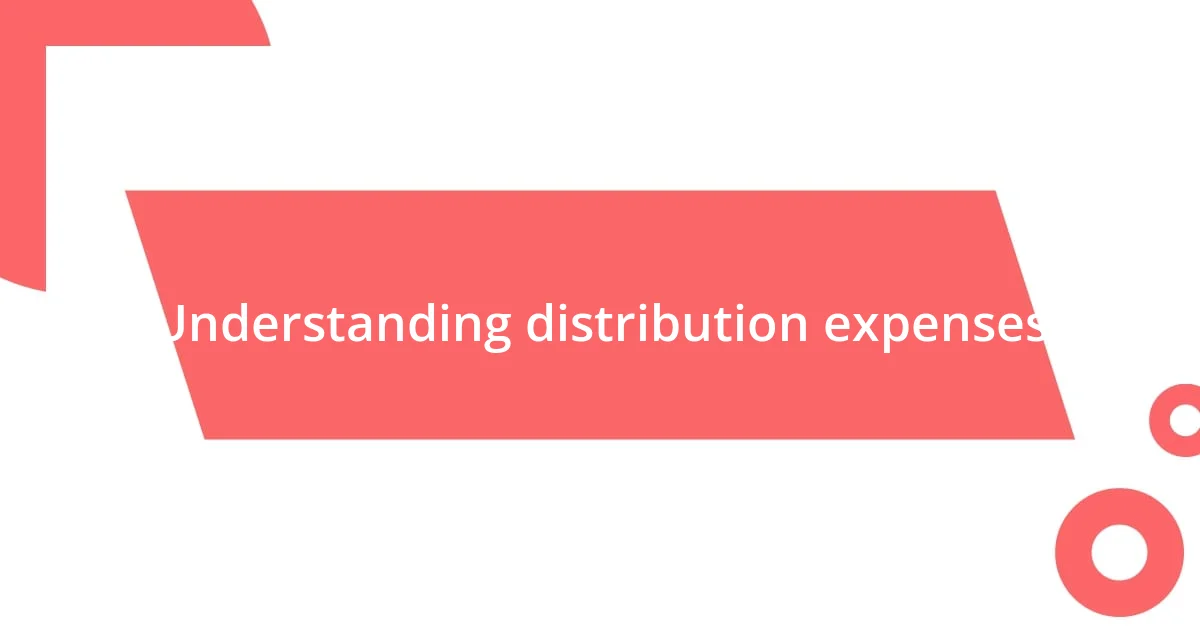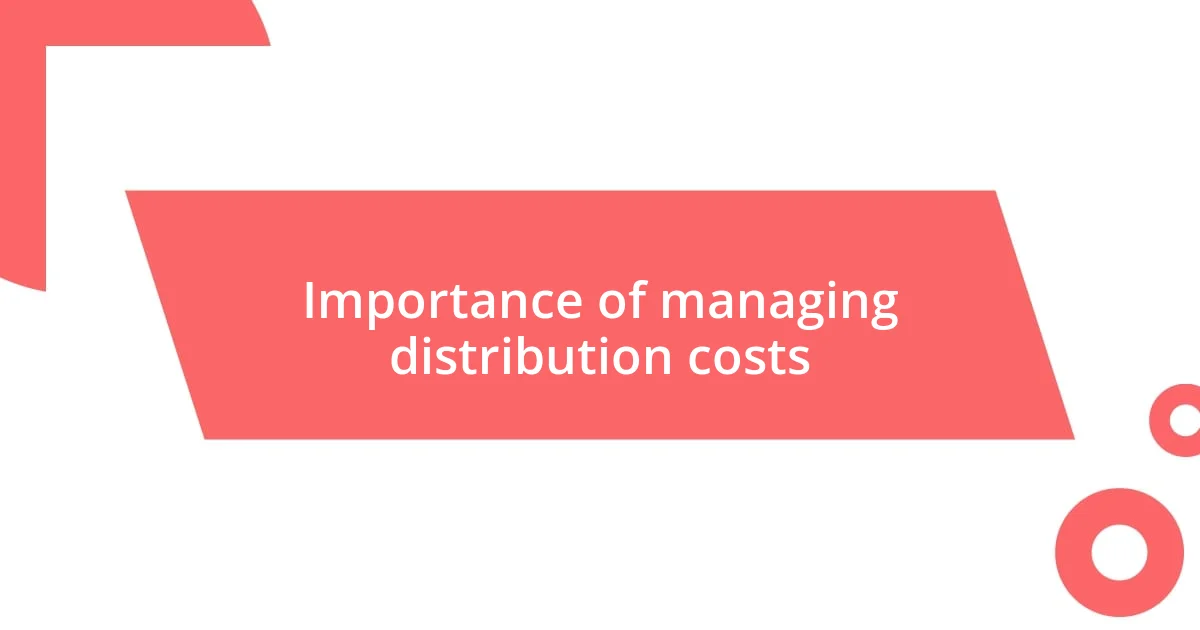Key takeaways:
- Distribution expenses are critical to a business’s financial health, encompassing various costs such as transportation, warehousing, and hidden fees that can impact profit margins.
- Effective management of distribution costs can lead to significant savings, improved cash flow, and enhanced competitive advantage by allowing businesses to balance quality and efficiency.
- Analyzing distribution expense data helps identify trends and inefficiencies, enabling companies to make informed decisions that reduce costs and improve customer satisfaction.

Understanding distribution expenses
When I first delved into distribution expenses, it struck me how crucial they are for a business’s overall financial health. It’s not just about getting the product from point A to B; these costs encompass everything from warehousing to transportation, and I found that understanding them can be a game-changer for budget management. Have you ever noticed how that seemingly small shipping fee can add up and impact profits?
One thing I learned through experience is that distribution expenses can vary significantly based on the chosen logistics strategy. For instance, I once worked with a company that opted for a premium shipping service, thinking it would enhance customer satisfaction. Little did we know that those costs would eat into our margins, forcing us to reassess our approach. It made me realize that each expense tells a story—one that could either lead to success or financial strain.
I also discovered that distribution expenses often involve hidden costs, like fuel surcharges or unexpected delays. Reflecting on a project where we had to pivot due to an unforeseen supply chain disruption, I felt the weight of those hidden fees. This experience reinforced my belief that a thorough understanding of these expenses isn’t just beneficial; it’s essential for making informed decisions that can safeguard a company’s bottom line. What about you—have you encountered unexpected costs in your distribution strategy?

Importance of managing distribution costs
Managing distribution costs is essential for maintaining a healthy profit margin. Throughout my journey, I’ve seen firsthand how closely tracking these expenses can lead businesses to significant savings. In one instance, I worked with a startup exploring various shipping options. By analyzing their distribution costs attentively, we were able to shift to a more cost-effective carrier, which ultimately improved their cash flow. Have you ever closely monitored your expenses? The difference can be quite enlightening.
It’s intriguing to me how a small tweak in the logistics strategy can result in massive cost savings. I remember a project where we experimented with consolidating shipments. Initially, I was skeptical about the potential downsides, like delayed delivery times. However, the outcome was surprisingly positive—our expenses reduced dramatically, and client feedback remained solid. This situation opened my eyes to the idea that sometimes, thinking outside the box can yield excellent results. Have you ever considered re-evaluating your shipment methods for cost benefits?
Moreover, managing distribution costs plays a pivotal role in competitive advantage. I’ve encountered companies that tend to overlook these costs in favor of prioritizing product quality or marketing. However, I believe that if businesses ignore distribution expenses, they risk undermining their overall performance. Balancing quality with cost-efficiency can be challenging, but those who succeed can position themselves remarkably well in the market. It’s a reminder that every element of a business is interconnected, isn’t it?
| Aspect | Significance |
|---|---|
| Cost Savings | Reducing distribution costs directly impacts profit margins and overall financial health. |
| Competitive Advantage | Well-managed distribution expenses can enhance a business’s market position compared to competitors. |
| Cash Flow Improvement | Efficient management leads to better cash flow, allowing for reinvestment in growth. |

Key components of distribution expenses
The key components of distribution expenses revolve around various elements that can significantly impact a business’s cost structure. In my experience, I’ve discovered that understanding these components is crucial for making financially sound decisions. For instance, I recall collaborating with a small business that miscalculated storage costs. They underestimated the financial strain of maintaining excess inventory, which not only inflated their warehousing expenses but also limited their cash flow. A crucial takeaway for me was recognizing how each distribution expense intertwines with the company’s overall strategy.
Here are some key components of distribution expenses to consider:
- Transportation Costs: Includes shipping fees, fuel surcharges, and carrier charges, which can fluctuate based on distances and logistics partners.
- Warehousing Fees: Costs associated with storing goods before delivery, such as rent, utilities, and labor for warehouse staff.
- Packaging Expenses: Investments in protective packaging materials that can help minimize damage during transit.
- Inventory Management Costs: Expenses related to tracking and handling inventory, which can affect storage needs and distribution speed.
- Handling Costs: Charges incurred during loading and unloading goods, which may vary depending on the cargo type.
While examining these components, I was surprised to find how often companies overlook the hidden implications of each element. For example, I once advised a client to shift to a just-in-time inventory approach, which reduced their warehousing expenses significantly. However, the emotional kick came when customer satisfaction soared because clients received fresher products with quicker turnaround times. It reiterated for me that attention to these details could lead to tremendous overall benefits—both financially and relationally.

Strategies to reduce distribution expenses
One effective strategy I’ve found is renegotiating contracts with suppliers and carriers. For instance, I once assisted a company that had been locked into long-term shipping contracts without a review. After initiating discussions with their carriers, we secured better rates and improved service terms, ultimately leading to a noticeable drop in expenses. It’s amazing how proactive communication can yield financial benefits—have you thought about reviewing your current contracts?
Another area worth exploring is optimizing delivery routes. By using route-planning software that considers factors like traffic patterns and delivery windows, I helped a local business reduce their delivery times and fuel costs significantly. They couldn’t believe the savings once they saw the numbers, and it really opened my eyes to the profound impact technology can have on distribution. Is there a simple tech solution you could implement to streamline your logistics?
Streamlining packaging can also lead to considerable cost reduction. I remember a project where we switched to smaller,more efficient packaging materials. While initially, I worried about potential damage during transit, the result was a win-win: reduced packaging costs and a lower environmental footprint. It taught me that sometimes, prioritizing sustainability can also enhance your bottom line. Have you considered how your packaging choices influence both expenses and brand perception?

Analyzing distribution expense data
When analyzing distribution expense data, I often find myself diving deep into the numbers to uncover trends that might not be immediately apparent. For instance, during one project, I noticed that a client’s transportation costs were spiking disproportionately compared to their sales growth. This insight prompted a detailed review of their shipping routes and carrier partnerships. By addressing the inefficiencies, they not only saved money but also enhanced their delivery performance, making their clients happier in the process. Isn’t it interesting how a closer look at distribution data can unveil opportunities for improvement?
Another critical aspect is the relationship between warehousing fees and inventory turnover rates. I remember working with a business that had high warehousing costs but low turnover. They were holding onto outdated stock, which was tying up capital that could have been better spent elsewhere. After streamlining their inventory management approach, they saw significant savings—less clutter in the warehouse and more cash flow to invest in growth. Have you ever felt overwhelmed by excess inventory and wondered what improvements could be made?
Lastly, I must highlight the importance of packaging expenses—and how they can easily be overlooked in the grand scheme of distribution expenses. I once consulted with a startup that was using overly robust packaging to ensure product safety, which significantly drove up costs. When we re-evaluated their packaging choices, we found more efficient materials that protected the product without breaking the bank. The relief on their faces was palpable when I shared how this shift could positively impact their margins. Have you taken the time to assess whether your packaging choices align with your budget and values?















